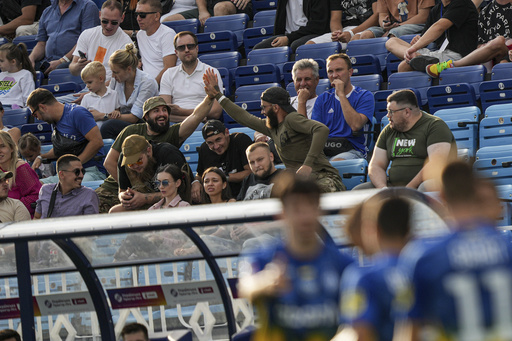KYIV, Ukraine — In Ukraine, the size of crowds attending soccer matches is dictated by the capacity of available bomb shelters. For the first time since the onset of the full-scale war in 2022, the Ukrainian Premier League is conducting a complete season with fans allowed in attendance, as restrictions on public gatherings tightened under martial law have now been relaxed.
Despite the persistent risk of airstrikes, fans of Dynamo Kyiv eagerly purchase the 1,700 tickets made available for each home match at the 16,000-seat Valeriy Lobanovskyi Stadium. Many supporters are excited to savor a fleeting moment of tranquility amidst the country’s fierce sporting rivalries.
Due to the war, Dynamo was forced to move its Europa League home matches to Hamburg, Germany; however, they continue to use their home stadium in Kyiv for domestic league games. Vitalii Kozubra brought his 9-year-old son Makar to see Dynamo, a contender for the title, take on Zorya Luhansk, a club that has been displaced due to Russian aggression in eastern Ukraine. “Even in wartime, this is something that brings people together for enjoyment,” Kozubra stated, highlighting the amicable atmosphere at the stadium, where fans from Zorya mingled with local spectators.
Young Makar was thrilled to witness the excitement of a live game compared to watching it on television. As the players entered the field wrapped in the blue and yellow of the Ukrainian flag, the crowd, which included service members and families with children, erupted into applause. The stadium buzzed with sounds of players giving their all and the impact of the ball. Children dashed to the sidelines for autographs from a few foreign players from Brazil, Senegal, Ivory Coast, and Panama who have remained in Ukraine despite the ongoing conflict.
Zorya faced no hostility from the home crowd as the match progressed. The league, featuring 16 teams, has been able to persist amidst mounting challenges. Matches are often set for early afternoons due to frequent power outages and the logistical complexities of traversing the vast expanse of Ukraine during wartime.
When air raid sirens interrupt the games—sometimes prolonging breaks for hours—players and spectators vacate to seek safety in shelters as alarms blare from loudspeakers and mobile devices. “We’ve been fortunate in Kyiv this season, with no air raid alerts during our home matches,” explained Dynamo club spokesman Andrii Shakhov. “However, things are different for away matches… The longest disruption we experienced lasted over four and a half hours due to multiple alerts.”
Ukrainian soccer players become subject to the draft when they turn 25, but clubs can request exemptions under business protection clauses. Currently, two teams are consistently playing away from their home stadium due to the war, while two others have ceased operations altogether due to damage sustained by their arenas.
Soccer’s roots in Ukraine stretch back to its Soviet era when it was a powerhouse, producing prominent players and coaches. In the 1980s, fan movements frequently expressed Ukrainian identity, directly opposing Soviet authority. After independence in 1991, soccer continued to be a source of national pride during various political and economic upheavals. The national team reached the quarterfinals of the 2006 World Cup and co-hosted the European Championships in 2012.
Rivalries among fans have been set aside, as many have united for over a decade, supporting one another in protests against Russian dominance during the 2013-2014 uprisings. Ultimately, they organized military recruitment efforts to join the fight against the ongoing conflict. “Dexter,” a red-bearded Dynamo enthusiast and military contractor, elaborated on the unity among rival fanbases. “We needed to band together against a common foe. Internal conflicts became irrelevant when rival fans found themselves fighting side by side in the military,” he explained while strolling his dog along the Dnipro River.
Fan organizations are playing active roles across the war efforts, participating in combat, fundraising, supporting veterans, and providing technical skills to the military. Dynamo’s officials estimate that over 80% of their fanbase before the war is now serving or taking on military duties.
Eight hours east of Kyiv, servicemen from the 3rd Assault Brigade were seen playing soccer on a pitch amid bombed ruins. Many fighters there had been recruited through soccer-related channels. “Organized fan groups are significantly contributing to our military efforts because they are incredibly motivated,” said a serviceman with the call sign “Shtahet,” who supports Dynamo and is currently deployed.
Combat medic “Poltava” expressed the importance of soccer as a means of boosting morale. “We gather whenever possible and rent facilities for games. There’s little else for entertainment, so football is our sole joy,” he remarked. Back in Kyiv, a Dynamo supporter known by his call sign “Escobar” was thankful for the opportunity to catch a match while on leave before returning to active duty. “This is football; it’s just a game,” he stated, dressed in military attire and wearing a camouflage bucket hat, after Dynamo’s 2-0 victory over Zorya. “There’s no animosity between the teams, and it’s heartwarming to witness such camaraderie.”
Goals from Vitaliy Buyalskyi and Maksym Braharu in the second half secured the victory for Dynamo, and even as the Zorya players felt disheartened leaving the field, they received applause from the fans, reflecting a shared sense of unity despite the challenges faced.




